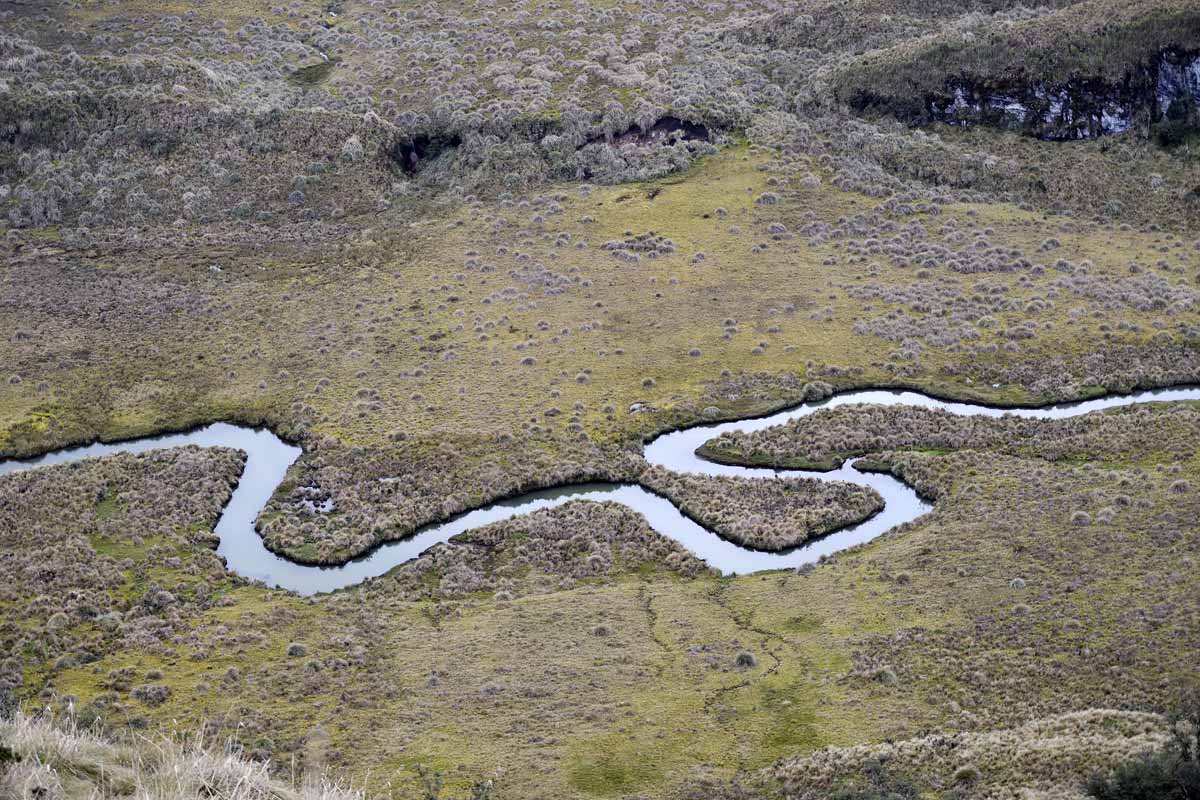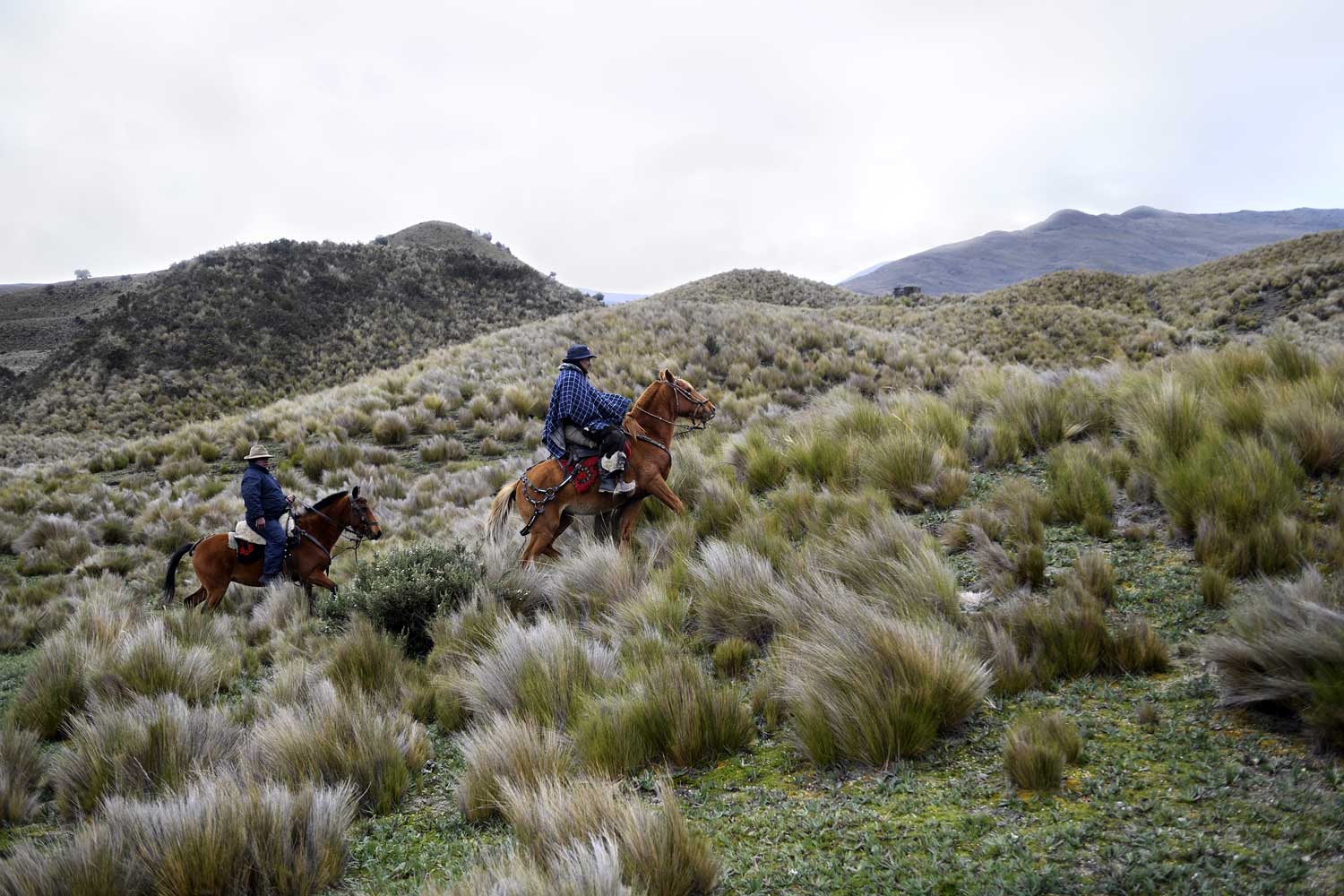The guardians of the sources
It's freezing cold. The wind whistles. A gentle drizzle falls from the sky, and the ground cedes like a sponge with every step. It is an inhospitable and at the same time fascinating place from which Ecuador's capital Quito gets its water. At 3,500 metres above sea level, in the páramos, the shrublands of the Andes, lies the origin of most of the country's rivers - both those that flow into the Pacific Ocean and those that water the Amazon lowlands and finally flow into the Atlantic Ocean.

"This ecosystem is extremely sensitive. It works like a giant sponge“, says biologist Carla Pérez. „Mosses and grasses all have an important function. They have to absorb the water and store it in the soil.“ These storage chambers then release it slowly in small ponds, that turn into little streams, which become wild rivers and finally turn into huge, lazy streams in the Amazon lowlands.
"This ecosystem is extremely sensitive. It works like a giant sponge“, says biologist Carla Pérez. „Mosses and grasses all have an important function. They have to absorb the water and store it in the soil.“ These storage chambers then release it slowly in small ponds, that turn into little streams, which become wild rivers and finally turn into huge, lazy streams in the Amazon lowlands.
That makes the paramos a predictable water storage system. Different from glaciers, which in summer or under climate-induced warming suddenly release enormous masses of water that can transform into life-threatening avalanches. This is the reason why the páramos are a strategic resource for Andean countries like Ecuador.
Around 12,000 square kilometres of Ecuador are covered by páramos. In the greater Quito area alone, around 5 million people depend on the water collected in the páramos and, to a lesser extent, in the glaciers of the surrounding mountains. But the natural water reservoir is under threat.

First by climate change which means that pests and also crops are climbing ever higher due to rising temperatures. Potatoes, for example, are already cultivated at up to 3,700 meters. Another danger is the influence of humans. Pastures for cattle are a major problem because the hooves of the animals compress the soil, reducing its storage capacity. In addition, their excrements contaminate the water at the source. Slash-and-burn land clearance also destroys the sensitive mosses and lichens that take years to recover from this, while roads and power lines cut the landscape. But the greatest threat is open-pit mining. The Andes mountain ranges contain valuable minerals, from copper to silver, lithium and gold. Mining companies are not only interested in the mineral resources, but also in the disponibility of fresh water, necessary for mining operations. Companies eyed the páramos because getting water from there free of charge is much better than costly desalination of seawater and pumping it up into the heights.
In neighbouring Colombia, the constitutional court therefore placed the páramos under protection in 2016 and forced the government to cancel drilling and mining licenses. Mountain villages now hold referendums in which mining is regularly refused. But the neoliberal government is reluctant to acknowledge this. This leads to constant conflicts, legal disputes and militarisation of affected regions. Ecuador has taken a different path, one that combines forces rather than splitting them. The páramos are also protected in Ecuador. But here, thanks to a sophisticated management model, the Fonag water fund, they have a lot of advocates who all work together - from companies to farmers to state institutions. Everybody is aware of the importance of the páramos and benefits from their protection. Together, they form a massive front against mining companies.

One oft hem is Oswaldo Ayaje. The peasant had little understanding of the effects of the shrublands before. He lives in Oyacachi, a small, indigenous village at the foot of the Cayambe-Coca National Park. "Nothing grew in such a high altitude, not even potatoes, so the páramo had no special value for us," he remembers. Only the cows found some grass there - but not very nutritious either. Today, Ayaje no longer sends his cows to the mountain pastures, but breeds trout and is one of 20 park rangers. For his cows he cultivates nutrient-rich concentrated feed mixtures at lower altitudes. And all this is thanks to a collaboration with Fonag, the water fund of the city of Quito, for which biologist Pérez also works.
When water suddenly became scarce in Quito in the 1990s due to a persistent drought, environmentalists, entrepreneurs and politicians forged an alliance and in the year 2000 set up the world’s first water fund. "This is a piggy bank into which everyone throws money," describes Pablo Lloret the basic idea. He is a fomer director of Fonag, now environmental director of Quito's municipal water company (Emaps). "The state, the private sector and environmentalists participate. This gives the water fund an inclusive and cooperative character," says Lloret. The shareholders contribute their respective expertise and monitor each other, which fosters transparency and efficiency. Partnerships with schools and universities provide the scientific basis and environmental education for future generations. Many universities have set up weather stations in the páramos and collect climate data for research. "We also benefit from this data. If, for example, rivers swell due to heavy rainfall, we can warn the people living downstream in d time and arrange evacuations," says biologist Pérez.
Six were the founding members in 2000: Quito's water company, the environmental organization The Nature Conservancy, the Cerveceria Andina brewery, the municipal energy company, Swiss development aid and the beverage producer Tesalia. Each contributed with 21,000 USD. The fund uses the interests and currently 2% of Quito's water charges to cover its current expenses and build up its reserves. The only purpose of the Fonag is to protect the páramos. "He gives nature a voice," says Lloret - and above all, money administrated by experts.

Fonag’s model later inspired the Ecuadorian constitution of 2007, which for the first time granted rights to nature. In Lloret's view, the Fonag has several advantages: "It has a long-term horizon, is financially and politically independent, is led by experts with a clear purpose which shields it from political turmoil and economic crises that are very common in Latin America.“ In the region, Fonag has become a role model. From Brazil to Mexico, public servants and experts are queuing up. The Inter-American Development Bank (BID) has also become a fan of the Fonag model, as it fits into its public-private-partnership scheme. There are now 22 water funds in Latin America. But not all copies are as sophisticated and balanced as the Fonag. Sometimes private interests predominate or the funds are more of a superficial marketing gag for companies. In other cases they are underfinanced or not independent of politics, which makes them vulnerable to political interference and corruption.
Text: Sandra Weiss / Photos: Florian Kopp
View the complete feature with video at Mongabay